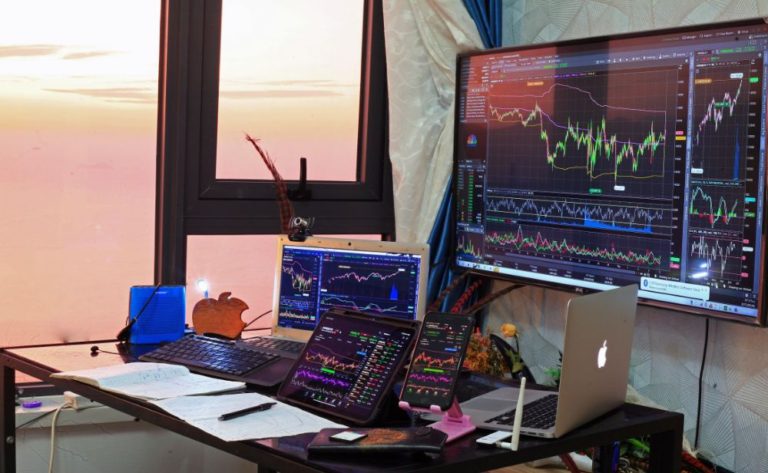FAST FACTS
• Minimum account balance: $0 (standard); $20,000 (Premium)
• Fees: Spread cost; Commissions; Overnight financing expenses; Inactivity fees; fees for deposits/withdrawals, bank wire transfers, debit card transactions, and ACH transactions.
• Ideal For: Experienced traders seeking an exceptional desktop trading experience
OANDA, which was co-founded by Drs. Stumm and Olsen in 1996, promotes that it specializes in “all things currency,” including currency conversion, FX data services for corporations, and an established global online brokerage service for consumers looking to trade the retail FX and CFD markets.
OANDA provides two account categories, standard and premium, and a product library that includes a vast array of CFD and spread betting solutions across a variety of asset classes, but not all are accessible in every country it serves. In addition to foreign exchange, the broker offers indices, metals, commodities, and bonds for trading opportunities across all financial markets.
Depending on the region, OANDA offers varied levels of account protection to the majority of its customers. OANDA Europe Limited provides negative balance protection as stipulated by the ESMA, whilst OANDA Asia Pacific Pte Ltd offers guaranteed stop loss orders. U.S. clients are the exception, as OANDA Corporation does not provide such security for their accounts.
In the United States, OANDA ranks highly in the CFTC’s Retail Forex Obligation report, which “represents the total amount of funds at an FCM, RFED, or FCMRFD that would be obtained by combining all money, securities, and property deposited by a retail forex customer into a retail forex account or accounts, adjusted for realized and unrealized net profit or loss.”2
OANDA is among the elite of online forex brokers due to its transparent website, emphasis on client education and research, different user interfaces, and global regulatory monitoring.
KEY TAKEAWAYS
• OANDA is one of the leading FX brokers in the United States based on customer funds held.
• OANDA allows U.S. clients for currency transactions exclusively and is registered with the CFTC, NFA (U.S.), and FCA (U.K.).
• OANDA provides clients with an exceptional desktop trading experience and outstanding research facilities.
Who OANDA Serves
OANDA provides clients with access to a wide range of financial products, but is best suited for seasoned traders seeking an exceptional desktop trading experience. Regional product options vary. For instance, U.S. clients can only trade foreign exchange, but the broker offers rapid and reliable transaction execution, industry-leading research resources, user-friendly interfaces, and verified regulatory oversight.
Pros
• Accepts U.S. clientele
• Governed by the FCA and NFA
• Well designed platforms
• Excellent research services
Cons
• No account protection for American customers
• There are no guaranteed stop losses for the United States or the United Kingdom. clients
• Neither cryptocurrencies nor single-stock CFDs are accessible to traders.
• Numerous additional expenses
The Pros Described
• OANDA is one of the few global online forex brokers that accept U.S. clients.
• OANDA Corporation is a registered FCM and RFED with the CFTC and an NFA member (#0325821).3 OANDA Europe is authorized and regulated in the United Kingdom by the FCA (#542574). The Financial Services Compensation Scheme (FSCS) provides clients with an additional £85,000 in asset protection.4
• fxTrade is a good trading platform due to its well-designed interface and quantity of necessary tools and information, such as Dow Jones FX Select news and several sorts of calculators. In addition, the incorporation of TradingView, “an excellent financial visualization technology,” within OANDA’s desktop and web-based platforms is a significant advantage.
• OANDA’s economic analyses, real-time news feeds, calendars, and extensive data analytics are uncommon for retail trading platforms.
Cons Explanation
• OANDA does not offer “negative balance protection” to clients in the United States. This means that U.S. traders with negative account balances may owe the broker money.
• OANDA does not offer guaranteed stop loss orders (GSLO) for the United States or the United Kingdom. clients.
• OANDA does not offer individual stocks, ETFs, industrial sectors, or cryptocurrencies, limiting its CFD offering to 55, which is significantly less than its competitors.
• In addition to costs for deposits/withdrawals, bank wire transfers, debit card, and ACH transactions, OANDA levies a monthly inactivity fee.
Costs
As is typical in the brokerage market, OANDA derives money through the spread supplied to the client. Its spread structure is quite simple and consists of two pricing options: “spread only” and “core pricing + commission.”5 The “spread only” option generates revenue through customer trades that “cross” the bid/ask spread, while the “core pricing + commission” option adds a standard $50 per million base commission to the raw spread. Commission fees are gathered and recorded as cash adjustments to customer accounts.
These pricing choices are readily accessible on OANDA’s website(s) and are available for both account types offered by the broker, albeit with varying spreads. For instance, the minimum EUR/USD spread for U.S. clients on a “regular” account under the “spread only” model is 1.3 pips, whereas the raw spread under the “core pricing Plus commission” approach is 0.4 pips.
Spreads are nevertheless vulnerable to market volatility and liquidity despite OANDA’s promotion of an automated engine that attempts to closely track global pricing. In accordance with its commitment to openness, OANDA releases historical spread data for all asset classes.
The “advanced trader program” is a three-tiered reward structure for high-volume traders that is available to U.S. clients. Spread or commission discounts, a “dedicated relationship manager,” API assistance, free VPS and wire transfers, and cheap access to third-party platforms are among the advantages. Tier 1 requires a minimum deposit of $20,000 or monthly volume more than $10 million. Tiers 2 and 3 require monthly volume ranges of $100-$500 million and $500+ million, respectively.
OANDA does not have a minimum deposit requirement for customers wishing to open a “standard” account, but logic dictates that this amount will be subject to the margin requirements of the customer’s smallest trade size.6 “Premium” accounts require a minimum deposit of $20,000, which grants the client additional perks such as unlimited free wire transfers.
OANDA’s overnight FX financing fees are stated as “a combination of underlying liquidity providers’ tom-next rates, modified by our x% annual administration fee.”5
The broker also provides costs for deposits/withdrawals, bank wire transfers, debit card and ACH transactions.
Trade Experience
OANDA provides clients with four ways to trade the markets, with fxTrade serving as its main product and being accessible by download (desktop), browser, and mobile application. In addition, it offers the popular MetaTrader 4 (MT4) desktop download, as well as mobile trading on portable smart devices.
OANDA’s major user interface, fxTrade, is well-designed and offers clients access to trading instruments, sophisticated order types, and account analytics. The desktop edition features both proprietary and advanced charting from Tradingview. Clients can access OANDA’s research solutions, such as MarketPulse and Autochartist technical analysis, straight from the platform, albeit the products will open in a new web page. The “order book” of OANDA reveals client mood, whereas “depth of market (DOM)” reveals supply/demand dynamics. Moreover, a multitude of useful tools and resources, such as Dow Jones FX Select news and a variety of calculators, make fxTrade a great trading platform.
In addition to the majority of the capabilities of the downloading edition, the web-based solution provides Tradingview charts with advanced studies and display styles. Additionally, clients can trade directly from charts. There are also adjustable watchlists, news feeds, browser-based research options (economic analysis, MarketPulse), and API access.
The customer can define trade defaults for particular instruments based on a specified quantity of base currency, a percentage of leveraged NAV, or an amount in the account’s currency. This provides the client with greater trading flexibility and benefits in their overall risk management.
Through partnerships with third-party providers MultiCharts, CQG FX, and TradingView, OANDA gives clients “a more robust and dynamic trading experience.” In addition, they provide VPS capabilities via third-party vendors BeeksFX, Liquidity Connect, and Commercial Network Services (CNS).
fxTrade has four basic order types with the possibility to attach “take profit” and/or “stop loss” orders.7 A “trailing stop loss” order is also available. In addition, customers can select their stops and limits based on price or pips, and the order ticket displays relevant information such as “pip value,” “trade value,” and “margin necessary.”
• Market – The simplest order in which a trader requests that their trade be completed at the current market rate.
• Limit – A pending order in which the entry price is either below or above the current market price, depending on whether the order is to buy or sell. The trader also has the option of choosing the order’s expiration time.
• Stop – A pending order in which the entry price is at a predefined level above or below the current market price, depending on whether the order is to buy or sell. The trader also has the option of choosing the order’s expiration time.
• Stop-Limit – A pending order in which the entry is at a specified point above or below the current market rate, depending on whether the order is to buy or sell, but the trader can choose the upper/lower bound for execution. For instance, if the market gap exceeds the chosen rate and the upper/lower bound, the order is instantly canceled. The trader also has the option of choosing the order’s expiration time.
OANDA Desktop.
Traders can also utilize the popular MetaTrader 4 (MT4) platform. Numerous traders value MT4’s advanced charting, research, watchlists, and trade automation via “expert adviser” plugins. Because the MT4 platform is an industry standard, traders transferring to OANDA from other brokers will be acquainted with its features. On the negative, the application’s appearance is somewhat old, and some of its features might be cumbersome.
The fxTrade mobile trading platform packs an astonishing amount of functionality into a compact platform, such that it is nearly as comprehensive as the desktop application. Mobile devices provide access to OANDA’s trading instruments, sophisticated order types, and account analytics. As with the desktop version, the mobile platform offers charts with price overlays, indicators, and customizable display styles, as well as the opportunity to trade right from the screen. Also included are news feeds and economic analysis. It was convenient to be able to continue our trading and research on a mobile device that closely resembled our desktop experience.
OANDA’s client login page is functionally impressive. It enables the client to launch interfaces and manage account details, including depositing or withdrawing funds, adding sub-accounts, changing passwords, gaining access to APIs, and contacting customer service.
Account Management at OANDA.
OANDA’s primary concentration is on foreign exchange, which makes sense considering that the company’s slogan is “all things currency.”
• Forex
• Bonds
• Precious metals
• Indices
• Commodities
Although OANDA has sufficient variety to properly compete in the online broker landscape of 2020, it lacks in several categories. For instance, the broker does not provide specific stocks, ETFs, industrial sectors, or cryptocurrencies, limiting its total CFD offering to 55, which is significantly less than its competitors. As a point of comparison, some prominent forex brokers may offer anywhere between 1,000 and 10,000 CFDs.
Customer Support
OANDA’s customer service is available 24/7 via email. The broker’s advertised business hours are from Sunday 1 PM E.S.T. to Friday 6 PM E.S.T., although “live chat” and phone assistance are not available over the entire timeframe. In spite of limited chat and phone support availability, OANDA’s personnel were friendly and knowledgable when they could be reached.
The website’s knowledge base and searchable archive should answer the majority of inquiries regarding the trading platforms and order types. However, this expertise is probably insufficient for both highly experienced and rookie investors.
Education
A variety of instructional films and articles are accessible for both novice and seasoned investors. Live webinars also offer a wide range of topics, such as market analysis, platform education, economic analysis, and Q&A sessions. Minor annoyances include the fact that the photos and videos use inconsistent platforms and some of the material is out-of-date in comparison to the most recent trading platform updates. There is a lack of centralized information, making navigation difficult.
OANDA Learning.
New investors will require patience as they attempt to navigate the educational materials. The material for novices is of high quality but badly structured. It will be difficult for clients looking to build a plan and track their progress to determine what education has been finished and what should come next.
The OANDA classroom, which consists of a series of webinars, focuses mostly on real-time market analysis, but also contains a substantial amount of fundamental platform navigation and analysis that should assist close any educational gaps. Much of the advanced material focused on the use of particular tools rather than investment techniques. In conclusion, the educational resources were adequate but could have been better structured.
Portfolio Analysis
OANDA states that it provides a trading history analysis program powered by Chasing Returns. On the platform, basic real-time information regarding client behavior, such as transaction activity and profit/loss breakdown, is accessible. OANDA’s platform does not have tax accounting capabilities.
Trading is no longer a solitary activity, and an increasing number of traders rely on the opinions and observations of other traders. Social traders will find the OANDA platform lacking in experience. In addition to a forum, OANDA does not provide any social investment tools.
Investigate Amenities
Unusually for a retail trading platform, OANDA provides an extensive selection of economic analyses, real-time news feeds, calendars, and advanced data analytics. The “order book” reveals the emotions and conduct of traders. The combination of MarketPulse, Autochartist, Dow Jones news, and calendars provides the trader with a full set of analytical tools. The pattern matching algorithms and volatility analysis will be especially useful for more seasoned traders.
OANDA’s analysis tools permit traders to test their strategies utilizing standard coding languages and examine the impact of economic news directly on charts. Such capabilities are typically aimed at seasoned traders who require complex analytics and resources to deploy, test, and manage their trading strategies in real time.
OANDA’s Research Department.
Investment Trends research awarded OANDA many “highest customer happiness” honors, which is not surprising. Education and training are required to fully utilize such a vast diversity of tools and research, which is a potential downside. OANDA does provide education and support for the majority of its tools and functions, however it is fragmented and difficult to find.
Overall, it’s a really extensive offering and an area where OANDA excels, but if there’s one critique, it’s that the information is strewn over the website and trading platforms. Traders might anticipate a learning curve as they search for everything.
Security
OANDA Corporation is registered with the CFTC as a Futures Commission Merchant (FCM) and Retail Foreign Exchange Dealer (RFED) and is an NFA member (#0325821). FCA (#542574) has authorized and regulated OANDA Europe in the United Kingdom. The Financial Services Compensation Scheme gives clients additional asset protection of up to £85,000. (FSCS).
In addition, it is governed by the Investment Industry Regulatory Organization of Canada (IIROC), the Australian Securities and Investment Commission (ASIC), the Monetary Authority of Singapore, and International Enterprise Singapore.
Despite the extensive regulatory scrutiny, the protection afforded to each account in the event of a default is limited and may vary depending on where the account is housed. OANDA Europe Limited provides negative balance protection as stipulated by ESMA, while OANDA Asia Pacific Pte Ltd offers guaranteed stop loss orders. U.S. clients are an exception, as OANDA Corporation does not provide such security for their accounts8.
More information is accessible on OANDA’s regulatory and financial compliance page.
As evidenced by the lack of two-factor authentication (2FA) and biometric authentication for its mobile application, OANDA does just enough to meet regulatory standards.10 Its unwillingness to offer client accounts protection above and beyond the bare minimum required by regulators is somewhat puzzling given that OANDA has won numerous awards over the years for being at the forefront of customer service. One could argue that OANDA’s great reputation provides it the luxury of not offering additional security, but such a gamble could prove to be somewhat myopic on the part of management.
Nevertheless, OANDA’s efforts to establish itself as a reliable internet broker are commendable. The corporation reiterated its position by stating, “We believe that the retail trading industry as a whole will benefit from a more transparent approach in which brokers are held accountable for making questionable assertions or incorrectly reporting their interests.”11
Verdict
OANDA is well-known among seasoned currency market participants. Its proprietary platform, fxTrade, provides an exceptional desktop trading experience that, when combined with better research and analytical tools, is ideally suited for traders who are already familiar with retail foreign currency trading. The broker’s stated objective is to distinguish itself by superior trade execution and transparency, and all available evidence supports this assertion.
While the research offerings are extensive, the material is dispersed over OANDA’s website and platforms, which leaves something to be desired. Moreover, despite OANDA’s experience in the online brokerage industry, its restricted product options are quite unexpected, especially when compared to those of its competitors. Being NFA/FCA-regulated is a bonus, but the absence of slippage protection and additional deposit protections beyond what is mandated by regulators is cause for concern.
However, investors should find assurance in OANDA’s price transparency, platform technology, and worldwide regulatory monitoring. OANDA satisfies the requirements of seasoned traders seeking a well-designed desktop interface.
Methodology
Investopedia is committed to provide investors with objective, in-depth ratings and reviews of online brokers. Our reviews are based on a six-month evaluation of all areas of an online broker’s platform, including the user experience, the quality of trade executions, the products available on their platforms, pricing and fees, security, the mobile experience, and customer support. We built a rating scale based on our criteria and incorporated over 3,000 data points into our star-ranking system.
In addition, each broker we surveyed was required to complete a 320-point questionnaire regarding all areas of their platform that we evaluated. Many of the online brokers we investigated gave us in-office demonstrations of their platforms.







One Comment